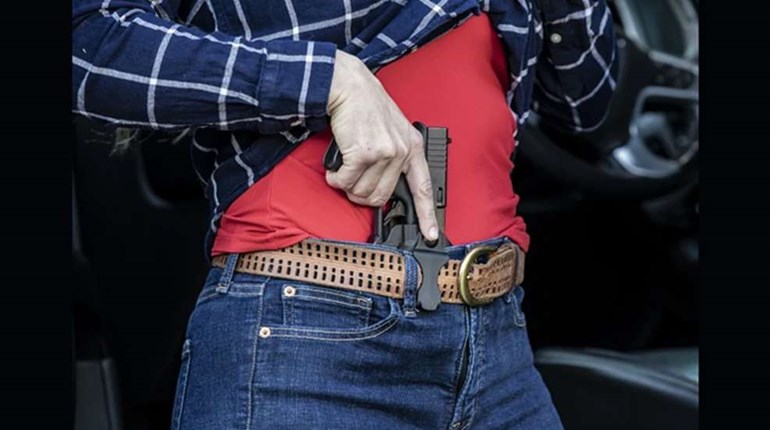
With the Echelon, Springfield Armory has combined popular features in such a way as to create what may be the apex polymer pistol.
The frame of the Echelon is polymer. The stainless-steel chassis—the actual firearm portion—which Springfield refers to as the Central Operating Group, or COG, includes the slide rails, the trigger mechanism, the striker release and ejector. You can remove the entire chassis as an assembly and swap it to another shell if you wish. This means that you could have one COG and several frames of various sizes, for summer/winter carry, or for everyday carry/competition use.
The slide is aggressively sculpted to provide gripping surfaces wherever you might be in the habit of using them, with beveling. There is also a set of “wings” at the back of the slide, to afford you more purchase. The beveling and angling of the serrations at the front of the slide act in the same manner as the wings at the rear of the slide, affording more traction. If you stick with the iron sights, the rear optics plate is also machined with a bevel, to get the corners of the serrations into your hand on manipulation, and the rear sight is machined with a flat-faced front edge. The slide also sports a tritium front blade and a “U” notch rear, a system Springfield calls “U-Dot.”

One thoughtful change was in eliminating the need for adapter plates to mount red-dot sights. Where other designs ship with a selection of adapter plates, Springfield went a different route with its VIS, or Variable Interface System. Once you remove the cover plate, the Echelon has locating holes in the slide and anchor pins as a set. Following a chart, you insert the locator/anchor pins, and those and the nubs on the optic will mesh and lock the optic to the slide. Bolt it down, and you’re good to go. This change also means that you don’t have the extra thickness of the adapter plate under your optic. Well, that’s for almost all optics—a few designs would require adapter plates, such as the Aimpoint ACRO, Steiner MPS and Burris Fastfire 4.
A cold-hammer-forged barrel with an integral feed ramp has been given a black Melonite surface treatment (like the billet-steel slide), so it is as hard and impervious as a tax-collector’s heart. The slide is moved by a recoil spring in a captured assembly, riding on its own guide rod.
 The slide-stop lever, while small and protected by a small shelf around it, is easily reached and used from either side of the frame. The magazine release is also ambidextrous, with the buttons on each side already functioning.
The slide-stop lever, while small and protected by a small shelf around it, is easily reached and used from either side of the frame. The magazine release is also ambidextrous, with the buttons on each side already functioning.
The shell has an accessory rail for mounting a light or laser. The grip sports a medium-grit pebble pattern, which, as you bear down, becomes more non-slip. There are also small texture panels above and forward of the trigger, which serve as index points for your trigger finger when it is outside of the trigger guard. Springfield is also currently offering three different sizes of grips, and three different sizes of backstraps, so you can easily get the right frame for your hands.
The Echelon’s trigger guard is oversized, which is helpful for those using it in cold weather with gloves; also, the join of the trigger guard to the frontstrap has been lifted to let your hand get higher on the frame. Speaking of triggers, the Echelon has a safety- bladed trigger with an excellent pull for a striker-fired pistol. I’m a trigger snob at times, so I snatched some polymer pistols out of the safe and reminded myself of the feel of the factory triggers … they were awful. Yep, the Echelon is excellent for a striker-fired pistol. The wide and gently curved trigger gives the impression of having less weight, the trigger comes back to a cleanly defined stop and then releases with a clean break. Reset is audible and can be felt, but it does not jarringly click.
Springfield even designed a new magazine for the Echelon. The standard magazine has a 17-round capacity, and, with the Echelon-specific extended basepad, that goes up to 20 rounds per tube. The steel tube has been given a scratch- and wear-resistant coating, so grit, powder residue and range debris should wipe right off. The gun comes with two magazines in the zippered carry case, so you’re ready for everyday carry right out of the box.
Testing was, in a word, boring. No malfunctions, no unexpected problems of any kind, just bullets accurately hurtling toward targets, empty brass being tossed to the side, and empty magazines hitting the dirt. All the optics in the shop were already in use on other pistols, so I had to do the accuracy testing the old-fashioned way, with iron sights. That, too, proved to be the good kind of boring, as the Echelon and its excellent trigger produced consistent groups on a regular basis. Felt recoil was not what you’d expect from a pistol this light, so the frame and grip distributed the recoil well, and even the sharpest loads were not a big deal to shoot well.
The Echelon is s a duty-sized pistol, so don’t expect it to easily disappear into your waistband. But, with the right holster and spare magazine carrier, you could walk out the door each morning with 38 rounds of 9 mm emergency options. I also think it would do well in competition. When more grips are available, it may well happen that Springfield offers a more-compact grip, and shorter magazines to go with it, to support carrying concealed.


































